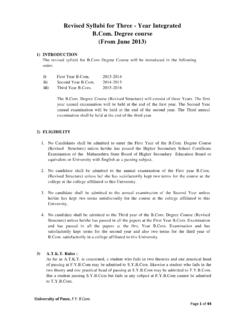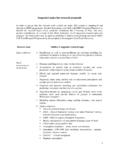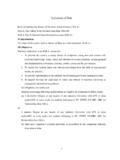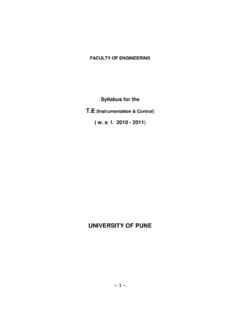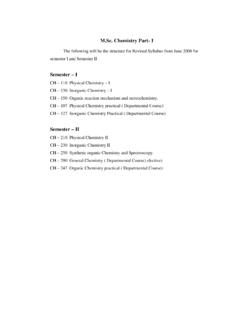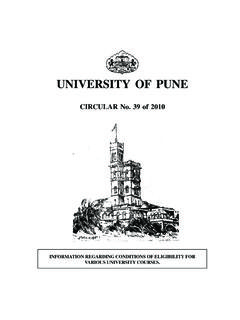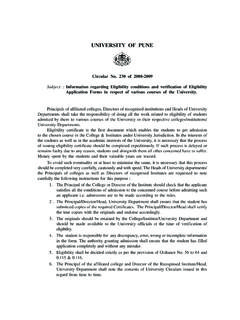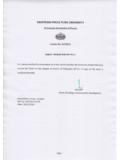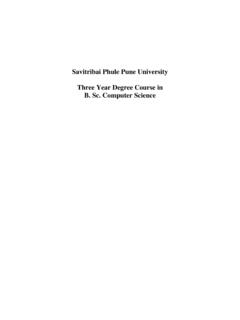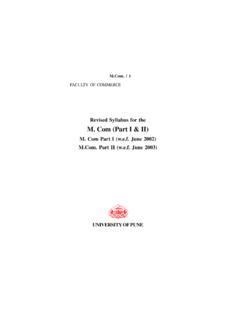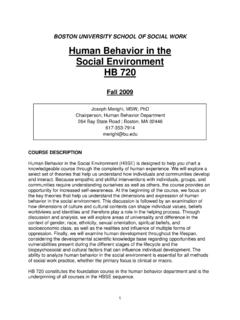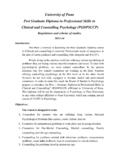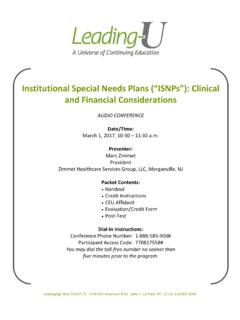Transcription of SYLLABI OF BACHELOR OF PHARMACEUTICAL …
1 SYLLABI OF BACHELOR OF PHARMACEUTICAL sciences first YEAR B. PHARMACY (T) PHARMACEUTICS-I (Theory) 90 Hrs. (3 hrs per week) Topic No Name of the topic and contents Hrs SECTION-I 1 Introduction to Pharmaceutics and its scope- definition of Pharmacy, Pharmaceutics. Area of Pharmaceutics- Physical pharmacy, Biopharmaceutics, PHARMACEUTICAL Technology, Microbiology, Dispensing and Pharmacy Practices. Historical background and development of profession of pharmacy and PHARMACEUTICAL Industry in India. 2 2 Introduction to pharmacopoeias and other compendia. 2 3 Definition of Drug, New Drug as per D&C Act 1940, steps for New Drug Development- filing of INDA (Investigational new drug application), clinical research, filing of NDA ( New Drug Application).
2 3 4 Brief Introduction to Good Manufacturing Practices & Quality Assurance 2 5 Introduction to Dosage forms - Classification of the basis of nature, routes of administration (only definitions), concept of new drug delivery system- sustained release & targeted drug delivery system with some examples. 6 6 Concept of pre-formulations and formulation- Introductory aspects of physicochemical properties with their application, types of additives with examples. 6 7 Concept of Bio-availability, Bioequivalence, Biopharmaceutics, Absorption, and Mechanism of absorption. Concept of drug distribution, Concept of drug metabolism and concept of drug excretion. Drug efficiency & dose response concept. Physiological consideration of various routes of administration 7 8 Radiopharmaceuticals: Radioactivity, Production and Quality control of radiopharmaceuticals.
3 3 9 Packaging: Containers, closures, and materials for them, unit dose packing. 4 10 Alternative systems of medicine: Ayurveda, Homoeopathy, Unani and Siddha. 3 SECTION-II 11 Solution Definition, factors affecting rate of solution, methods used to improve solubility and preformulation studies. Types of ingredients used during formulation. Manufacturing processes involved in liquid oral preparation. Evaluation (Viscosity determination, weight per ml & specific gravity, deliverability) including control on raw materials, in process control and finished Product controls. Formulation - syrups, elixirs, aromatic water, linctuses, ENT preparations and paints, mouth washes. 12 1512 Equipments used in manufacturing & packing of oral solution, liquid mixing- mechanism of mixing, Impeller, Propeller mixers, Paddle mixer, baffles, prevention of aeration & foam.
4 3 13 Filtration & Clarification: factors affecting rate of filtration, types of filter media used, filter aids, plate& frame filter with modification, leaf filter, rotary filter & hydro extractors. 5 14 Size Reduction: Importance in pharmacy, factors affecting size reduction Grinding mills of various types like Hammer mill, Multimill, Ball mill, Edge and End runner mill, Fluid energy mill. 4 15 Size Separation: Standards of sieves as per official books, powder gradation, size distribution methods, techniques for size separation. 4 16 Powders- formulation preparation & evaluation of various powders like Dusting powder, oral rehydration powder, tooth powders, & dry syrup formulation.
5 Mechanism of powder mixing, factors affecting mixing, Sigma & ribbon blender, Paddle mixer, Tumblers like cubes & double cone, Planetary mixer & Equipments used in the production of powders. 7 17 Granule manufacturing as a dosage form:- Methods of granulation, Environmental controls required for manufacturing of effervescent granules. Pouch filling machine. 3 PHARMACEUTICS -I (Practical) 90 Hrs. (3 hrs/week) 1. Wherever possible Pharmacopoeial products should be prepared. 2. Latest textbooks and pharmacopoeias should be referred. 3. For all preparations tests will include organoleptic tests and simple tests such as density (wt/ml), specific gravity, angle of repose, bulk density etc: student are not expected to perform assays and other long time evaluation parameters.
6 Only simple tests are to be performed in the university examination. 4. Only two preparations should be given in the annual practical examination and one of that should be evaluated by simple tests [1] Monophasics: 1) Solution A) Aqueous Iodine Solution (Lugol) IP B ) Tincture of Iodine IP C) Solution of Cresol With Soap IP D) Surgical Chlorinated Soda Solution E) Paracetamol Pediatric Solubalised Drops F) Strong Solution Ammonium Acetate G) Magnesium Citrate Solution NF12 2) Aromatic Waters A) Concentrated Dill Water BP B) Dill Water C) Conc. Anise Water BPC 16 D) Chloroform Water E) Gripe Water-Modified Aromatic Water 3) Liniments A) Liniment of Turpentine IP B) Liniment of Camphor C) Soap Liniment 4) Syrups A) Simple Syrup IP B) Artificial Syrup C) Cough Syrup 5) Elixirs A) Piperazine Citrate Elixir 6) Linctus A) Simple Linctus B) Medicated linctus.
7 7) Ear And Nose Preparation A) Ear Drop Containing Antibiotics (Ex. Gentamycin /Chloramphenicol) B) Ephedrine Hydrochloride Nasal Drop [2] Glycerites A) Glycerin Of Boric Acid B) Tannic Acid Glycerin C) Glycerin Of Starch [3] Powders A) Oral Rehydration Powder B) Dry Syrup Formulation For Reconstitution C) Talcum Powder, Tooth Powder D) Effervescent Granules. Recommended Books 1. Ansel s Introduction to PHARMACEUTICAL dosage forms & Drug Delivery Systems 2. Modern Dispensing Pharmacy by A. P. Pawar. & R .S. Gaud, 2nd Ed, Career Publication. 3. Pharmaceutics the Science of dosage form design by M. E. Aulton 2nd Ed. Churchill Livingstone. 4. Dittert, Sprouls American pharmacy (J. B. Lipincott) 5. Martin, Remington s PHARMACEUTICAL sciences , (2005) 176. Harkishin Singh, Pharmacopoeias and Formularies, Vallabh Prakashan, New Delhi.
8 7. Shroff of General Pharmacy Series. 8. A Text Book of PHARMACEUTICAL Formulations by B. M. Mithal, 6th Ed., Vallabh Prakashan, Delhi 9. The Theory & Practice of Industrial Pharmacy by L. Lachman & H. A. Liebermann, 3rd Ed., Varghese Publishing House, New Delhi. 10. Indian Pharmacopoeia 1996, British Pharmacopoeia 2004, British PHARMACEUTICAL Codex, United State Pharmacopoeia 28, National Formulary 23 2005. 11. Introduction to PHARMACEUTICAL Engineering by Paradkar 10th Ed, Nirali Prakashan, Pune. MODERN DISPENSING PRACTICES (Theory) 60 Hrs. (2 hrs per week) Topic No Name of the topic and contents 1 Pharmacy profession: Code of PHARMACEUTICAL Ethics Pharmacy as a career Pharmacist as health care provider. 2 2 Prescription and its parts Types, parts of prescription Responding to prescription, pricing of prescription. 2 3 Meaning of compounding and dispensing Fundamental operations in compounding and dispensing, containers, closures for dispensed products, labeling of dispensed medicines, Storage and stability of medicines.
9 3 4 Good compounding and dispensing practices: Personnel, house keeping, building. Documentations Introduction to prescription filling, drug profile, PMR, ADR, Purchase records, Stock records, Idiosyncratic cases 3 5 PHARMACEUTICAL calculations Alligations, percentage calculations, molarity, normality, millimoles, milliequivalence calculations, Isotonic solutions, proof spirit, improvisation and dilution of dosage forms. 3 6 Posology Meaning, factors affecting dose, calculation of doses for infants and children. 2 7 Patient counseling: Steps involved. Patient counseling about diseases and medicines and for prescription drugs. Pharmacist consultation for OTC and Cosmetics. 3 8 Types, formulation, compounding and dispensing aspects of: 1. Solutions mouthwash, gargles, syrups, linctus, elixirs, enemas, ENT preparations 2.
10 Suspensions (with respect to stability) 7 183. Emulsions (with respect to stability) SECTION-II Topic No Name of the topics Hrs. 9 Types, formulation, compounding and dispensing aspects of: 1. Ointments, pastes, gels, creams 2. Powders Divided, bulk, granules 3. Pills, Tablet triturates 4. Pastilles, lozenges 5 10 Suppositories and pessaries Bases, additives, preparation, displacement value and calculations 3 11 Incompatibilities in prescription Study of various types of incompatibilities: physical, chemical and therapeutic with examples of drug-drug and drug food interactions. Methods to remove these incompatibilities. 3 12 Drug law related to retail pharmacy and Code of ethics. 3 13 Sutures and ligatures Classification, processing, sterilization, packaging and quality control. 3 14 Compounding and dispensing aspects of: 1.
